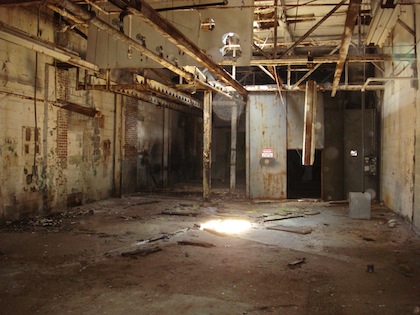The case of the contaminated former CTS facility in Mills Gap has taken a new twist, as Buncombe County last week responded to the property owner’s appeal of its move to demolish the derelict plant building. The county provided property owner Mills Gap Road Associates with a list of measures needed to stop demolition procedings.
Meanwhile, the EPA continues to analyze the case for listing the property on the Superfund program’s National Priorities List — a move that would place the site among the most contaminated in the nation.
In a Sept. 21 “order to remedy,” the county demands that the owners secure and maintain all window and door openings; replace a large section of the roof; remove exposed wood framing along the back of the building; remove bundles of clothing still stored in portions of the building; and remove a ladder that provides access to the roof. The order stipulates that the work must be completed by a licensed contractor within 60 days, or the order appealed within 10 days, if the owners want to avoid demolition.
An appeal at this point would move the case into the political arena, placing the issue on the agenda of an upcoming County Commissioners meeting. The order notes that failure to either complete the work or file an appeal is a misdemeanor under state law.
Residential neighbors of the derelict building have called for demolition to proceed, saying the building is a hazard and a nuisance. They note that it has attracted vandals who have stolen copper pipes and left extensive grafitti. A plume of contamination by hazardous chemicals is alleged to lie underground, the presumed source of TCE, vinyl chloride, and other toxic chemicals that have shown up in area wells, springs, and surface water.
Records show that when Mills Gap Road Associates acquired the property from the Indiana-based CTS in 1987, the latter warranted that the property was in compliance with all environmental laws and regulations. That claim has since been rejected by public agencies as well as area residents investigating the source of contamination found in soils, vegetation, surface and ground water downhill from the site. Residents have collected what they say is evidence of an illegal dumping system on the property; state records indicate that more chemicals were received at the facility than were trucked away for proper disposal while the electroplating facility was in operation.
Mills Gap resident Tate MacQueen has been a spokesperson for plant neighbors for years. “If the shell of the building goes and the contamination underneath is not addressed, then it’s just an exercise in beautification by concealing the wound. There is the potential for a whitewash here,” he maintains, “and that’s the last thing we can afford. This should be a case study for EPA Region 4, for how to turn a wrong into a right.”



Before you comment
The comments section is here to provide a platform for civil dialogue on the issues we face together as a local community. Xpress is committed to offering this platform for all voices, but when the tone of the discussion gets nasty or strays off topic, we believe many people choose not to participate. Xpress editors are determined to moderate comments to ensure a constructive interchange is maintained. All comments judged not to be in keeping with the spirit of civil discourse will be removed and repeat violators will be banned. See here for our terms of service. Thank you for being part of this effort to promote respectful discussion.